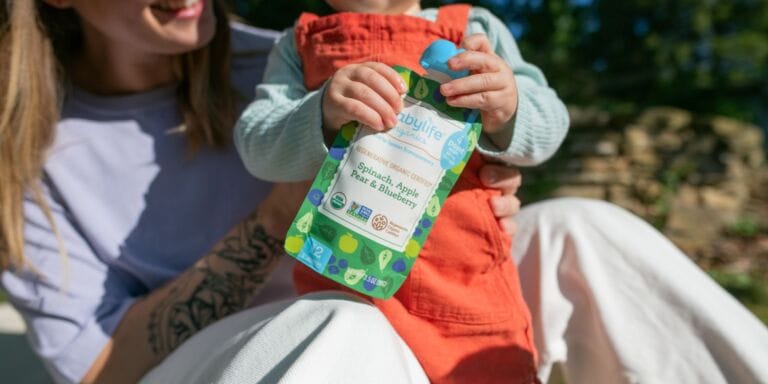Raising a vegetarian baby

8 ways to confidently raise your kid with a meat-free diet.
Vegetarian kids have gone more mainstream in the last decade, and it’s not uncommon for vegetarian parents to want to pass their meat-free lifestyle onto their children. But while you may be a pro at being a vegetarian, feeding your baby a healthy, balanced and satisfying meatless diet can be tricky. After all, children have very specific nutritional needs, and not eating meat doesn’t mean that they don’t need the nutrients in meat. So before you get going, you need to know how to compensate and ensure that a vegetarian lifestyle does not impede on baby’s daily dietary intake of crucial nutrients, like iron and zinc.
The good news is, a meatless diet, if done well, can not only provide excellent nutrition for all stages of childhood, but also can offer health benefits in the prevention and treatment of certain diseases. For example, children raised on vegetables, whole grains, and legumes could potentially be exposed to less carcinogens and toxins associated with eating meat, and a nutritious plant-based diet can be healthier in decreasing the amounts of dietary intake of saturated fat and cholesterol that children consume.
So if you are thinking about raising a vegetarian baby, here are 8 tips to make sure you do it right.
1. Introduce Grains. Try to favor whole grains. The complex carbohydrate that’s found in whole grains is a great source of energy for your little one’s busy schedule of hitting milestones after milestones. Doctors recommend that you incorporate solid foods to baby’s diet between the age of 4 and 6 months; and many parents start with infant cereals. Rice contains arsenic, so oatmeal or barley-based options are better alternative; and since wheat is a common allergen, make sure to consult with your pediatrician to know when you should introduce it to your little one’s diet.
2. Opt of iron-fortified foods. Babies’ iron stores start to decrease when they’re around 4 to 6 months, and iron deficiency, which is very common among vegetarians, can affect a child’s growth and development. So when you’re ready to introduce solids to your little one’s diet, choose iron-fortified baby cereals and, as baby grows, move on to puréed beans and dark leafy greens like kale and spinach. The iron that’s in plants is harder for the body to absorb than the iron find in animal products. To boost your little one’s iron absorption, you should add a source of vitamin C, such as oranges and bell pepper, to his meal.
3. Don’t stop dairy. In the first year of life, breast milk and/or formula are considered the primary sources of nutrition. Once your baby is ready for solids, you could start introducing whole milk yogurt or cottage cheese in addition to milk consumption. Not only will it up your baby’s intake of protein, it will ensure that he gets the calcium he needs.
4. Eat the rainbow. When introducing vegetables, try to offer all the colors of the rainbow. Not only will it be fun for baby to have a colorful plate, but it will ensure a variety of nutrients. For example, each color variety of vegetables contains different phytonutrients and antioxidants. It’s good to start with vegetables and fruits that are light on the stomach and then slowly introduce additional produce. A good practice is to find what’s local and seasonal so as to limit pesticide exposure and secure organic produce.
5. Diversify. Once you get into a good pattern of initial grains, milk and vegetable purees, you can slowly start to diversify. There are a variety of grains to offer including quinoa, amaranth and millet. These can be blended with vegetables or cooked until soft in vegetable broth to offer additional nutritional support.
6. Find protein elsewhere. When your baby turns 8 to 9 months, you may get the thumbs up from the pediatrician to introduce protein varieties. If you don’t want your little one to eat meat, then make sure to compensate and find protein in other ingredients. Protein deficiency isn’t common in the US, but your little one may be more prone to it if he follows a vegetarian diet. Lacking protein can lead to delayed growth and development and a weakened immune system. So prevent any deficiency, give your little one eggs, nuts and nut butters, tofu and legumes like lentils and yellow moong.
7. Understand what “healthy” vegetarianism is. It’s important to consider the depth of vegetarianism. Being a vegetarian — whether you are 1 or 30 years old — doesn’t mean constantly fueling on refined starches, pastas, pizza, and breads. Rather, you want to prioritize whole grains, legumes, and an extensive variety of vegetables. Foods such as soups, smoothies, stews, and baked whole grain pasta dishes (i.e. casserole) could offer excellent nutrition for your baby onwards to childhood. To add flavor without adding salt and sugar intake, make use of fresh herbs and flavor your foods naturally.
8. Consult your pediatrician. You want to let your pediatrician know that you are raising a vegetarian baby so he or she knows to test of nutritional deficiency. Your doctor may also prescribe supplements. Vitamin B12, for example, is primarily found in meat products. So your little one may need a supplement to get adequate amount.





































